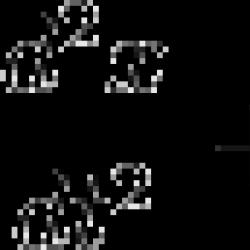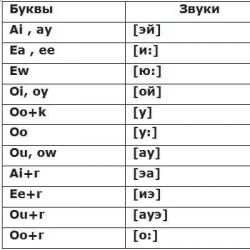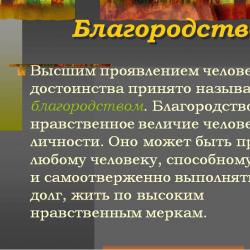Using the graph of harmonic oscillations, write down the equation. Equation of harmonic vibrations. Logarithmic damping decrement
Harmonic oscillation is a phenomenon of periodic change of any quantity, in which the dependence on the argument has the character of a sine or cosine function. For example, a quantity oscillates harmoniously and changes over time as follows:
where x is the value of the changing quantity, t is time, the remaining parameters are constant: A is the amplitude of oscillations, ω is the cyclic frequency of oscillations, is the full phase of oscillations, is the initial phase of oscillations.
Generalized harmonic oscillation in differential form
![]()
(Any non-trivial solution to this differential equation is a harmonic oscillation with a cyclic frequency)
Types of vibrations
Free vibrations occur under the influence of the internal forces of the system after the system has been removed from its equilibrium position. For free oscillations to be harmonic, it is necessary that the oscillatory system be linear (described by linear equations of motion), and there is no energy dissipation in it (the latter would cause attenuation).
Forced vibrations occur under the influence of an external periodic force. For them to be harmonic, it is enough that the oscillatory system is linear (described by linear equations of motion), and the external force itself changes over time as a harmonic oscillation (that is, that the time dependence of this force is sinusoidal).
Harmonic Equation
|
Equation (1)
|
gives the dependence of the fluctuating value S on time t; this is the equation of free harmonic oscillations in explicit form. However, usually the vibration equation is understood as a different representation of this equation, in differential form. For definiteness, let us take equation (1) in the form
![]()
Let's differentiate it twice with respect to time:
![]()
![]()
It can be seen that the following relationship holds:
which is called the equation of free harmonic oscillations (in differential form). Equation (1) is a solution to differential equation (2). Since equation (2) is a second-order differential equation, two initial conditions are needed to obtain a complete solution (that is, determining the constants A and included in equation (1); for example, the position and speed of the oscillatory system at t = 0.
A mathematical pendulum is an oscillator, which is a mechanical system consisting of a material point located on a weightless inextensible thread or on a weightless rod in a uniform field of gravitational forces. The period of small natural oscillations of a mathematical pendulum of length l, motionlessly suspended in a uniform gravitational field with free fall acceleration g, is equal to
and does not depend on the amplitude and mass of the pendulum.
A physical pendulum is an oscillator, which is a solid body that oscillates in a field of any forces relative to a point that is not the center of mass of this body, or a fixed axis perpendicular to the direction of action of the forces and not passing through the center of mass of this body.
Oscillations movements or processes that are characterized by a certain repeatability over time are called. Oscillations are widespread in the surrounding world and can have a very different nature. These can be mechanical (pendulum), electromagnetic (oscillatory circuit) and other types of vibrations.
Free, or own oscillations are called oscillations that occur in a system left to itself, after it has been brought out of equilibrium by an external influence. An example is the oscillation of a ball suspended on a string.
Special role in oscillatory processes has the simplest form of oscillations - harmonic vibrations. Harmonic oscillations form the basis of a unified approach to the study of oscillations of various natures, since oscillations found in nature and technology are often close to harmonic, and periodic processes of a different form can be represented as a superposition of harmonic oscillations.
Harmonic vibrations are called such oscillations in which the oscillating quantity changes with time according to the law sine or cosine.
Harmonic Equationhas the form:
where A - vibration amplitude (the magnitude of the greatest deviation of the system from the equilibrium position); -circular (cyclic) frequency. The periodically changing argument of the cosine is called oscillation phase . The oscillation phase determines the displacement of the oscillating quantity from the equilibrium position at a given time t. The constant φ represents the phase value at time t = 0 and is called initial phase of oscillation . The value of the initial phase is determined by the choice of the reference point. The x value can take values ranging from -A to +A.
The time interval T through which certain states of the oscillatory system are repeated, called the period of oscillation . Cosine is a periodic function with a period of 2π, therefore, during the period of time T, after which the oscillation phase will receive an increment equal to 2π, the state of the system performing harmonic oscillations will repeat. This period of time T is called the period of harmonic oscillations.
The period of harmonic oscillations is equal to : T = 2π/ .
The number of oscillations per unit time is called vibration frequency
ν.
Harmonic frequency
is equal to: ν = 1/T. Frequency unit hertz(Hz) - one oscillation per second.
Circular frequency = 2π/T = 2πν gives the number of oscillations in 2π seconds.
Graphically, harmonic oscillations can be depicted as a dependence of x on t (Fig. 1.1.A), and rotating amplitude method (vector diagram method)(Fig.1.1.B) .
The rotating amplitude method allows you to visualize all the parameters included in the harmonic vibration equation. Indeed, if the amplitude vector A located at an angle φ to the x-axis (see Figure 1.1. B), then its projection onto the x-axis will be equal to: x = Acos(φ). The angle φ is the initial phase. If the vector A bring into rotation with an angular velocity equal to the circular frequency of oscillations, then the projection of the end of the vector will move along the x axis and take values ranging from -A to +A, and the coordinate of this projection will change over time according to the law:
.
Thus, the length of the vector is equal to the amplitude of the harmonic oscillation, the direction of the vector at the initial moment forms an angle with the x axis equal to the initial phase of the oscillations φ, and the change in the direction angle with time is equal to the phase of the harmonic oscillations. The time during which the amplitude vector makes one full revolution is equal to the period T of harmonic oscillations. The number of vector revolutions per second is equal to the oscillation frequency ν.
Topics of the Unified State Examination codifier: harmonic vibrations; amplitude, period, frequency, phase of oscillations; free vibrations, forced vibrations, resonance.
Oscillations - These are changes in the state of the system that repeat over time. The concept of oscillations covers a very wide range of phenomena.
Vibrations of mechanical systems, or mechanical vibrations- this is the mechanical movement of a body or system of bodies, which is repeatable in time and occurs in the vicinity of the equilibrium position. Equilibrium position is a state of a system in which it can remain indefinitely without experiencing external influences.
For example, if the pendulum is deflected and released, it will begin to oscillate. The equilibrium position is the position of the pendulum in the absence of deviation. The pendulum, if left undisturbed, can remain in this position for as long as desired. As the pendulum oscillates, it passes through its equilibrium position many times.
Immediately after the deflected pendulum was released, it began to move, passed the equilibrium position, reached the opposite extreme position, stopped there for a moment, moved in the opposite direction, passed the equilibrium position again and returned back. One thing has happened full swing. Then this process will be repeated periodically.
Body oscillation amplitude is the magnitude of its greatest deviation from the equilibrium position.
Oscillation period - this is the time of one complete oscillation. We can say that during a period the body travels a path of four amplitudes.
Oscillation frequency is the reciprocal of the period: . Frequency is measured in hertz (Hz) and shows how many complete oscillations occur in one second.
Harmonic vibrations.
We will assume that the position of the oscillating body is determined by a single coordinate. The equilibrium position corresponds to the value . The main task of mechanics in this case is to find a function that gives the coordinate of the body at any time.
For a mathematical description of oscillations, it is natural to use periodic functions. There are many such functions, but two of them - sine and cosine - are the most important. They have many good properties and are closely related to a wide range of physical phenomena.
Since the sine and cosine functions are obtained from each other by shifting the argument by , we can limit ourselves to only one of them. For definiteness, we will use cosine.
Harmonic vibrations- these are oscillations in which the coordinate depends on time according to the harmonic law:
(1)
Let us find out the meaning of the quantities included in this formula.
A positive value is the largest modulus value of the coordinate (since the maximum value of the cosine modulus is equal to unity), i.e., the largest deviation from the equilibrium position. Therefore - the amplitude of oscillations.
The cosine argument is called phase hesitation. The value equal to the phase value at is called the initial phase. The initial phase corresponds to the initial coordinate of the body: .
The quantity is called cyclic frequency. Let's find its connection with the oscillation period and frequency. One complete oscillation corresponds to a phase increment equal to radians: , whence
(2)
(3)
The cyclic frequency is measured in rad/s (radians per second).
In accordance with expressions (2) and (3), we obtain two more forms of writing the harmonic law (1):
The graph of function (1), expressing the dependence of the coordinate on time during harmonic oscillations, is shown in Fig. 1 .
The harmonic law of type (1) is of the most general nature. It responds, for example, to situations where two initial actions were simultaneously performed on the pendulum: it was deflected by an amount and a certain initial speed was given to it. There are two important special cases when one of these actions was not performed.
Let the pendulum be deflected, but the initial speed was not reported (it was released without the initial speed). It is clear that in this case , therefore we can put . We get the cosine law:
The graph of harmonic oscillations in this case is shown in Fig. 2.
 |
| Rice. 2. Law of cosine |
Let us now assume that the pendulum was not deflected, but the initial velocity from the equilibrium position was imparted to it by impact. In this case, so you can put . We get the law of sine:
The oscillation graph is shown in Fig. 3.
 |
| Rice. 3. Law of sine |
Equation of harmonic vibrations.
Let's return to the general harmonic law (1). Let's differentiate this equality:
. (4)
Now we differentiate the resulting equality (4):
. (5)
Let's compare expression (1) for the coordinate and expression (5) for the acceleration projection. We see that the acceleration projection differs from the coordinate only by a factor:
. (6)
This ratio is called harmonic equation. It can also be rewritten in this form:
. (7)
From a mathematical point of view, equation (7) is differential equation. The solutions to differential equations are functions (not numbers, as in ordinary algebra).
So, it can be proven that:
The solution to equation (7) is any function of the form (1) with arbitrary ;
No other function is a solution to this equation.
In other words, relations (6), (7) describe harmonic oscillations with a cyclic frequency and only them. Two constants are determined from the initial conditions - from the initial values of the coordinate and velocity.
Spring pendulum.
Spring pendulum is a load attached to a spring that can oscillate in the horizontal or vertical direction.
Let us find the period of small horizontal oscillations of the spring pendulum (Fig. 4). The oscillations will be small if the amount of deformation of the spring is much less than its dimensions. For small deformations we can use Hooke's law. This will lead to the oscillations being harmonic.
We neglect friction. The load has a mass and the spring stiffness is equal to .
The coordinate corresponds to the equilibrium position in which the spring is not deformed. Consequently, the magnitude of the spring deformation is equal to the modulus of the coordinates of the load.
 |
| Rice. 4. Spring pendulum |
In the horizontal direction, only the elastic force from the spring acts on the load. Newton's second law for the load in projection onto the axis has the form:
. (8)
If (the load is shifted to the right, as in the figure), then the elastic force is directed in the opposite direction, and . Conversely, if , then . The signs and are opposite all the time, so Hooke’s law can be written as follows:
Then relation (8) takes the form:
We have obtained an equation of harmonic oscillations of the form (6), in which
The cyclic frequency of oscillation of the spring pendulum is thus equal to:
. (9)
From here and from the relationship we find the period of horizontal oscillations of the spring pendulum:
. (10)
If you hang a load on a spring, you get a spring pendulum that oscillates in the vertical direction. It can be shown that in this case, formula (10) is valid for the oscillation period.
Mathematical pendulum.
Math pendulum is a small body suspended on a weightless inextensible thread (Fig. 5). A mathematical pendulum can oscillate in a vertical plane in the field of gravity.
 |
| Rice. 5. Mathematical pendulum |
Let's find the period of small oscillations of a mathematical pendulum. The length of the thread is . We neglect air resistance.
Let us write down Newton's second law for the pendulum:
and project it onto the axis:
If the pendulum takes a position as in the figure (i.e.), then:
If the pendulum is on the other side of the equilibrium position (i.e.), then:
So, for any position of the pendulum we have:
. (11)
When the pendulum is at rest in the equilibrium position, the equality is satisfied. For small oscillations, when the deviations of the pendulum from the equilibrium position are small (compared to the length of the thread), the approximate equality is satisfied. Let's use it in formula (11):
This is an equation of harmonic oscillations of the form (6), in which
Therefore, the cyclic frequency of oscillations of a mathematical pendulum is equal to:
. (12)
Hence the period of oscillation of a mathematical pendulum:
. (13)
Please note that formula (13) does not include the mass of the load. Unlike a spring pendulum, the period of oscillation of a mathematical pendulum does not depend on its mass.
Free and forced vibrations.
They say that the system does free vibrations, if it is once removed from the equilibrium position and subsequently left to itself. No periodic external
In this case, the system does not experience any influences, and there are no internal energy sources that support oscillations in the system.
The oscillations of the spring and mathematical pendulums discussed above are examples of free oscillations.
The frequency with which free vibrations occur is called natural frequency oscillatory system. Thus, formulas (9) and (12) give the natural (cyclic) frequencies of oscillations of the spring and mathematical pendulums.
In an idealized situation in the absence of friction, free oscillations are undamped, that is, they have a constant amplitude and last indefinitely. In real oscillatory systems, friction is always present, so free vibrations gradually die out (Fig. 6).
Forced vibrations- these are oscillations made by a system under the influence of an external force that periodically changes over time (the so-called driving force).
Let us assume that the natural frequency of oscillations of the system is equal to , and the driving force depends on time according to the harmonic law:
Over some time, forced oscillations are established: the system makes a complex movement, which is a superposition of forced and free oscillations. Free oscillations gradually die out, and in a steady state the system performs forced oscillations, which also turn out to be harmonic. The frequency of steady-state forced oscillations coincides with the frequency
forcing force (an external force, as it were, imposes its frequency on the system).
The amplitude of the established forced oscillations depends on the frequency of the driving force. The graph of this dependence is shown in Fig. 7.
 |
| Rice. 7. Resonance |
We see that resonance occurs near the frequency - the phenomenon of an increase in the amplitude of forced oscillations. The resonant frequency is approximately equal to the natural frequency of oscillations of the system: , and this equality is fulfilled more accurately, the less friction in the system. In the absence of friction, the resonant frequency coincides with the natural frequency of oscillations, and the amplitude of oscillations increases to infinity at .
They have a mathematical expression. Their properties are characterized by a set of trigonometric equations, the complexity of which is determined by the complexity of the oscillatory process itself, the properties of the system and the environment in which they occur, i.e., external factors affecting the oscillatory process.
For example, in mechanics, a harmonic oscillation is a movement characterized by:
Straightforward character;
Unevenness;
The movement of a physical body, which occurs along a sinusoidal or cosine trajectory, depending on time.
Based on these properties, we can give an equation for harmonic vibrations, which has the form:
x = A cos ωt or the form x = A sin ωt, where x is the coordinate value, A is the vibration amplitude value, ω is the coefficient.
This equation of harmonic vibrations is fundamental for all harmonic vibrations, which are considered in kinematics and mechanics.
The indicator ωt, which in this formula is under the sign of the trigonometric function, is called the phase, and it determines the location of the oscillating material point at a given specific moment in time at a given amplitude. When considering cyclic fluctuations, this indicator is equal to 2l, it shows the quantity within the time cycle and is denoted w. In this case, the equation of harmonic oscillations contains it as an indicator of the magnitude of the cyclic (circular) frequency.
The equation of harmonic oscillations we are considering, as already noted, can take different forms, depending on a number of factors. For example, here is this option. To consider free harmonic oscillations, one should take into account the fact that they are all characterized by damping. In different countries, this phenomenon manifests itself in different ways: stopping a moving body, stopping radiation in electrical systems. The simplest example showing a decrease in oscillatory potential is its conversion into thermal energy.
The equation under consideration has the form: d²s/dt² + 2β x ds/dt + ω²s = 0. In this formula: s is the value of the oscillating quantity that characterizes the properties of a particular system, β is a constant showing the damping coefficient, ω is the cyclic frequency.
The use of such a formula allows us to approach the description of oscillatory processes in linear systems from a single point of view, as well as to design and simulate oscillatory processes at the scientific and experimental level.
For example, it is known that at the final stage of their manifestations they cease to be harmonic, that is, the categories of frequency and period for them become simply meaningless and are not reflected in the formula.
The classical way to study harmonic oscillations is in its simplest form a system that is described by the following differential equation of harmonic oscillations: ds/dt + ω²s = 0. But the variety of oscillatory processes naturally leads to the fact that there are a large number of oscillators. We list their main types:
A spring oscillator is an ordinary load with a certain mass m, which is suspended on an elastic spring. It performs harmonic type, which are described by the formula F = - kx.
A physical oscillator (pendulum) is a solid body that performs oscillatory movements around a static axis under the influence of a certain force;
- (practically not found in nature). It represents an ideal model of a system that includes an oscillating physical body with a certain mass, which is suspended on a rigid weightless thread.
We examined several physically completely different systems, and made sure that the equations of motion are reduced to the same form
Differences between physical systems appear only in different definitions of the quantity and in different physical senses of the variable x: this can be a coordinate, angle, charge, current, etc. Note that in this case, as follows from the very structure of equation (1.18), the quantity always has the dimension of inverse time.
Equation (1.18) describes the so-called harmonic vibrations.
The harmonic vibration equation (1.18) is a second-order linear differential equation (since it contains the second derivative of the variable x). The linearity of the equation means that
if some function x(t) is a solution to this equation, then the function Cx(t) will also be his solution ( C– arbitrary constant);
if functions x 1(t) And x 2(t) are solutions to this equation, then their sum x 1 (t) + x 2 (t) will also be a solution to the same equation.
A mathematical theorem has also been proven, according to which a second-order equation has two independent solutions. All other solutions, according to the properties of linearity, can be obtained as their linear combinations. It is easy to verify by direct differentiation that the independent functions and satisfy equation (1.18). This means that the general solution to this equation has the form:
Where C 1,C 2- arbitrary constants. This solution can be presented in another form. Let's enter the value
|
|
and determine the angle by the relations:
|
|
Then the general solution (1.19) is written as
According to trigonometry formulas, the expression in brackets is equal to
We finally come to general solution of the harmonic vibration equation as:
Non-negative value A called vibration amplitude, - initial phase of oscillation. The entire cosine argument - the combination - is called oscillation phase.
Expressions (1.19) and (1.23) are completely equivalent, so we can use any of them, based on considerations of simplicity. Both solutions are periodic functions of time. Indeed, sine and cosine are periodic with a period . Therefore, various states of a system performing harmonic oscillations are repeated after a period of time t*, during which the oscillation phase receives an increment that is a multiple of :
It follows that
Least of these times
called period of oscillation (Fig. 1.8), and - his circular (cyclic) frequency.
Rice. 1.8.
They also use frequency fluctuations
|
|
Accordingly, the circular frequency is equal to the number of oscillations per seconds
So, if the system at time t characterized by the value of the variable x(t), then the variable will have the same value after a period of time (Fig. 1.9), that is
![]()
The same meaning will naturally be repeated over time 2T, ZT etc.

Rice. 1.9. Oscillation period
The general solution includes two arbitrary constants ( C 1, C 2 or A, a), the values of which must be determined by two initial conditions. Usually (though not necessarily) their role is played by the initial values of the variable x(0) and its derivative.
Let's give an example. Let the solution (1.19) of the equation of harmonic oscillations describe the motion of a spring pendulum. The values of arbitrary constants depend on the way in which we brought the pendulum out of equilibrium. For example, we pulled the spring to a distance and released the ball without initial speed. In this case

Substituting t = 0 in (1.19), we find the value of the constant C 2
![]()
The solution thus looks like:
We find the speed of the load by differentiation with respect to time
![]()
Substituting here t = 0, find the constant C 1:
![]()
Finally
![]()
Comparing with (1.23), we find that is the amplitude of the oscillations, and its initial phase is zero: .
Let us now unbalance the pendulum in another way. Let's hit the load so that it acquires an initial speed, but practically does not move during the impact. We then have other initial conditions:

![]()
our solution looks like
![]()
The speed of the load will change according to the law:
![]()
Let's substitute here:
![]()







